Agent Insights
Overview
Agent Insights provides a way to create highly customized views into your agent performance. Metrics can be aggregated by individual human agent, or groups of agents, for a specified period of time.
Admins can create and save different Agent Views that highlight different groups of agents, and/or different metrics, that can then be shared with Admins, Staff Admins & Managers within your organization.
For help creating common views, reference the Agent Insights Playbooks section.
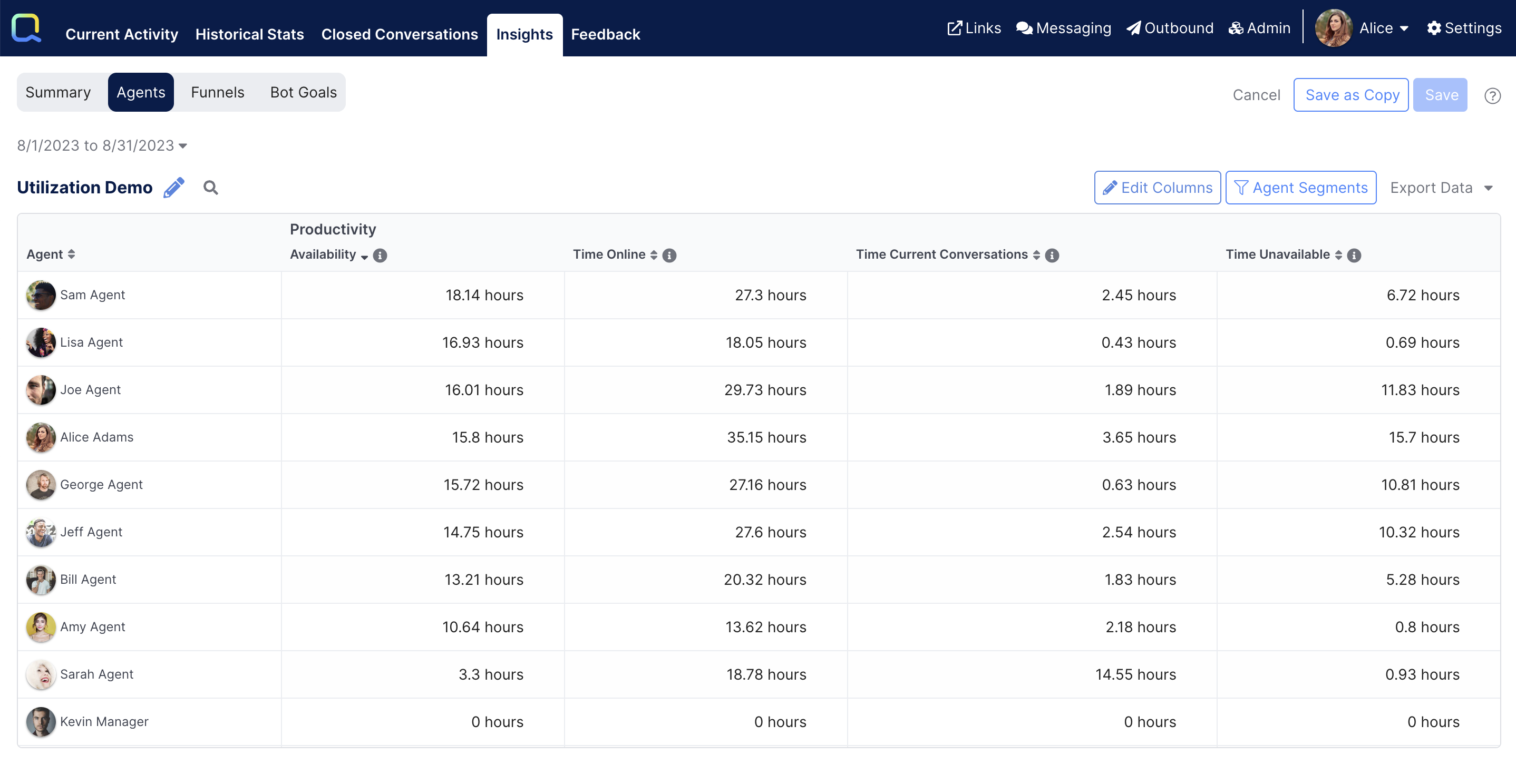
Views
A View is a version of the Agent Insights report that can be modified and saved to show a specific configuration. The first thing users will see when clicking into Agent Insights will be all the existing Views they have access to in their Quiq site:

The Agent Insights overview section, consisting of several Views
Administrators can create Views in order to:
- Only include certain agents
- Select additional metrics to display, including survey scores
- Hide any metrics that are not applicable to the audience
- Customize how the data is formatted, like the time units for duration columns, the decimal precision for number columns, or rather to show a percentage as a progress bar.
- Allow a View to be available to specific Manager users by Role
Opening a View
Navigating to the Agents tab within the Insights tab in Reports will show a list of all the Views the logged in user can access.
Admins will see all the Views that have been created. Staff Admins and Managers will only see Views they have been granted access to by Role:

Administrators can Copy or Delete a View from the list by choosing the buttons on the right. Only Administrators can create and edit Views.
In the beginning, Administrators will see messaging that no Views have been created. Simply click the get started link to create your first View. Staff Admins and Managers will not see the Agents tab until they have been granted access to at least one View.

Create a New View
The +New View button will create a new View that will have the base configuration by default. From here, an Admin can modify and save the View as desired.
Learn how to get started creating some common Agent Insight Views in Agent Insights Playbooks.
General Settings
Select the pencil icon to access the General Settings:

Within General Settings an Admin can manage the following:
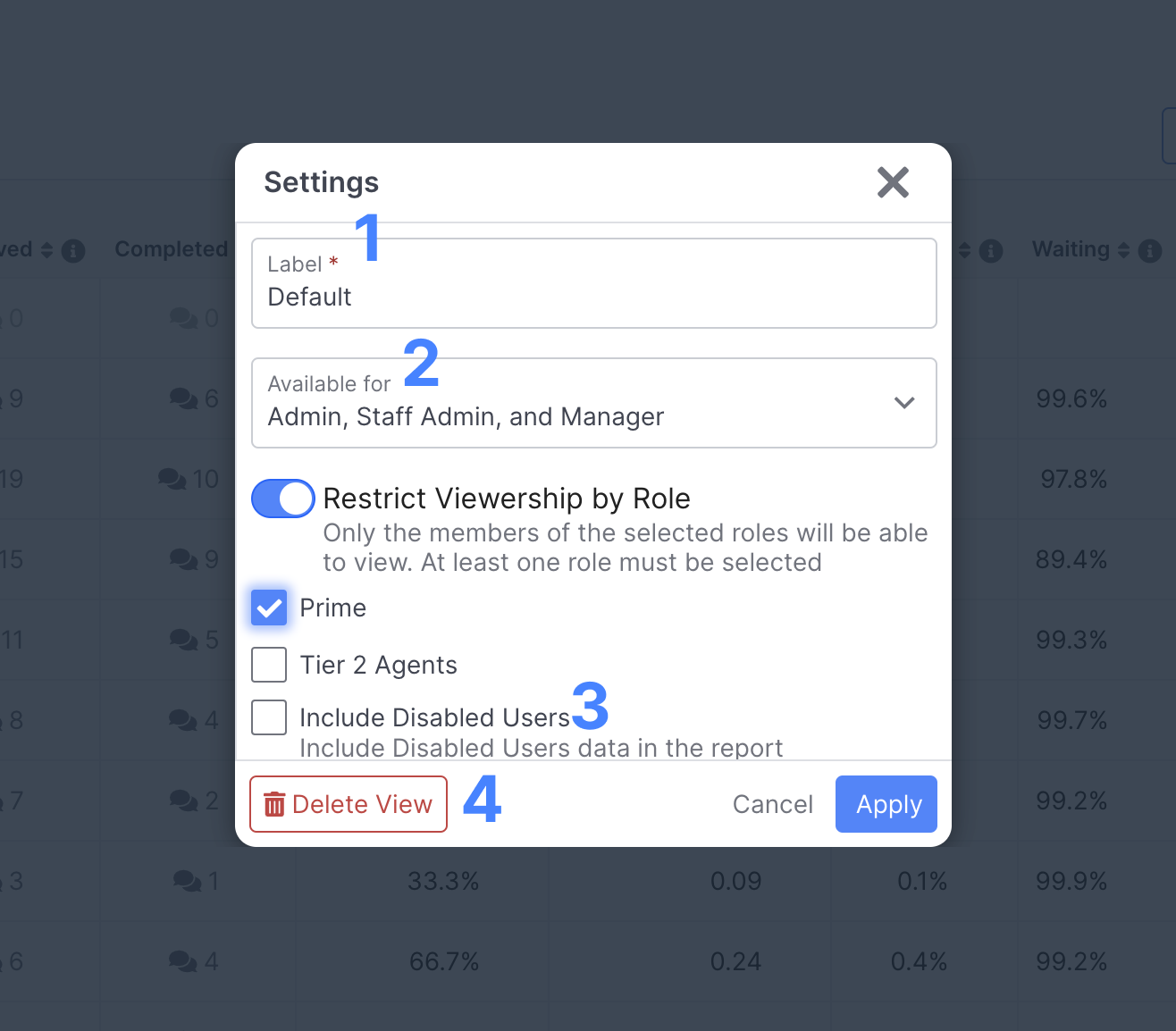
1. Label: Change the label name of the View
2. Available for: Grant viewer permission to sets of Users.
- Admin users will always see all Views.
- Staff Admin users and Managers will only see the View if it is marked as Available for Admin and Staff Admin or Admin, Staff Admin, and Manager.
- If the Restrict Viewership by Role toggle is disabled, all users for the selected permission set will see the View. If the toggle is enabled, then a non-Admin user must be a member of one of the selected routing roles in order to have access to the View.
3. Included Disabled Users: Include users who have been disabled in the report. Disabled user's ID will show rather than their first name/last name and their profile picture is not available.
4. Delete View: Delete the View. Once a View has been deleted, it is no longer accessible to any user.
Edit Columns
Select the Edit Columns button to customize which metrics are displayed as columns in the table, and how they are displayed:
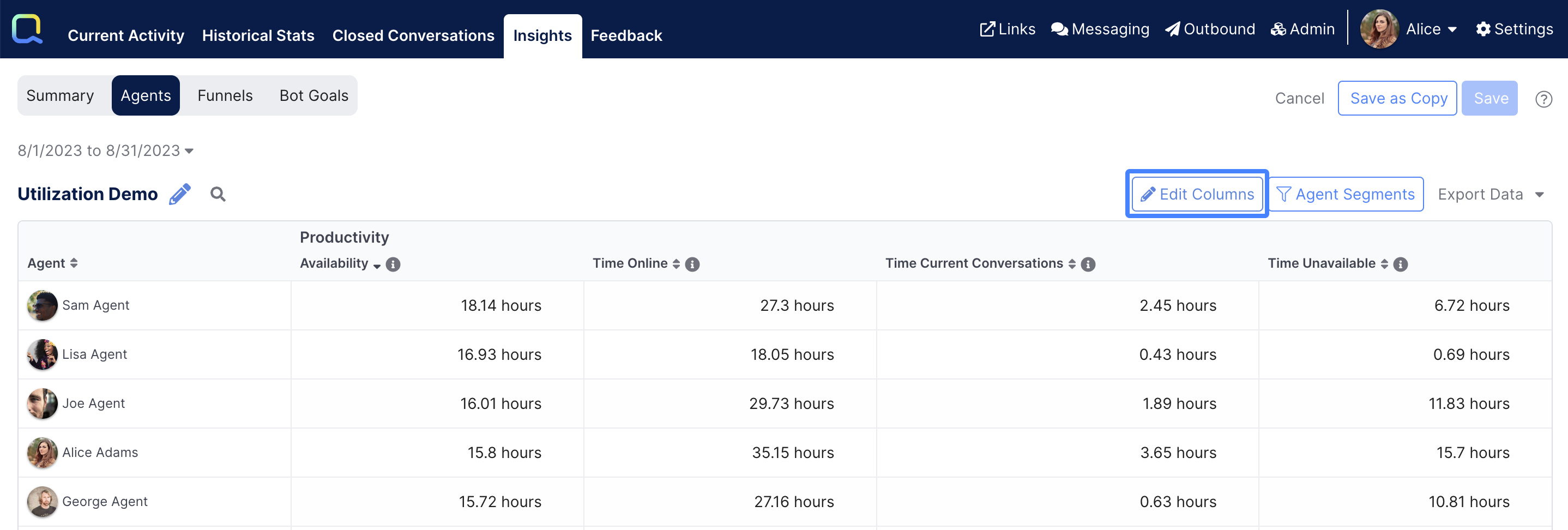
The left side of the dialog will show all of the available metrics by category:
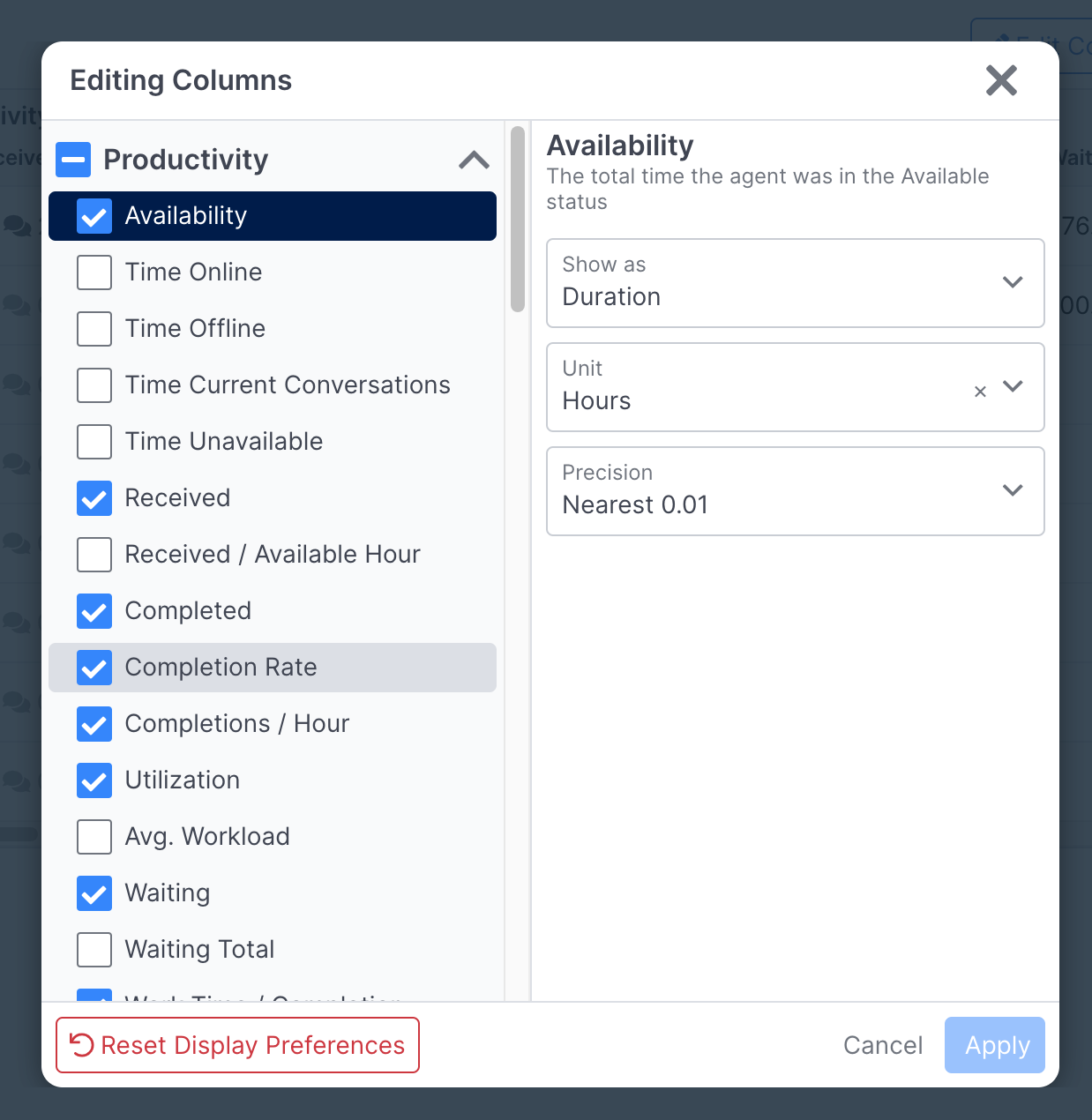
An Admin can check and uncheck available metrics to display or hide them as desired.
All the metrics for a section can be selected (or unselected) by checking the box in the the Category heading.
When a column is selected on the left, the right side shows the display options for that column:
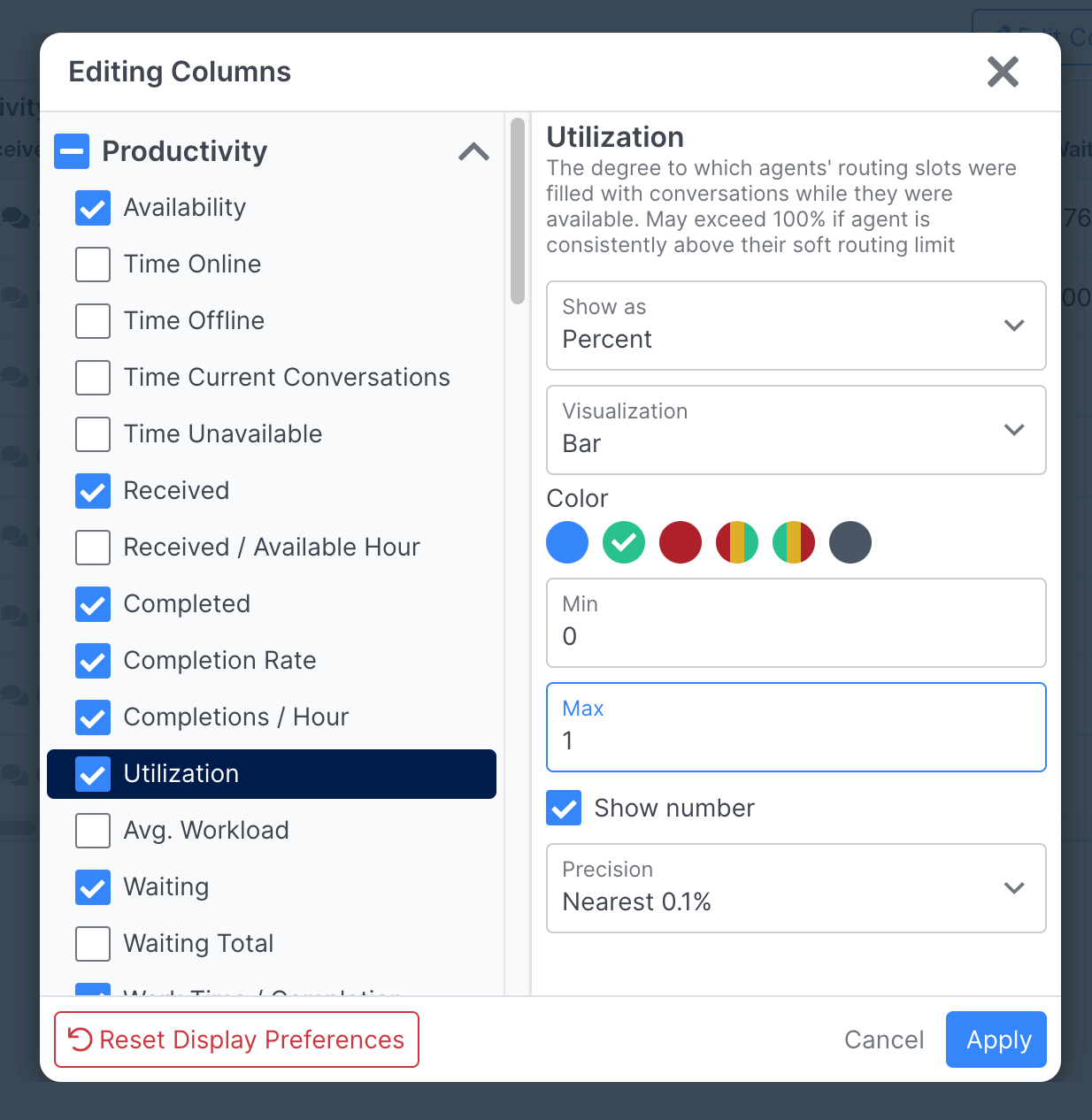
The types of display options differ by the type of field. Number and Percent fields allow visualization to be set to a number or a bar, and the decimal precision can be changed. Duration fields can have the displayed time units changed.
Reset Display Preferences will change all column visibility and display options back to that of the default base view.
Each View can have a maximum 50 visible metrics columns.
Agent Segments
Agent Segmentation can be applied to the Agents table much the same way as other Segments work in other Insights sections. This allows the data to be filtered to a subset of the agents, and also allows the data to be aggregated by a group of agents rather than each agent individually.
Select the Agent Segments button to apply or configure Agent Segments:
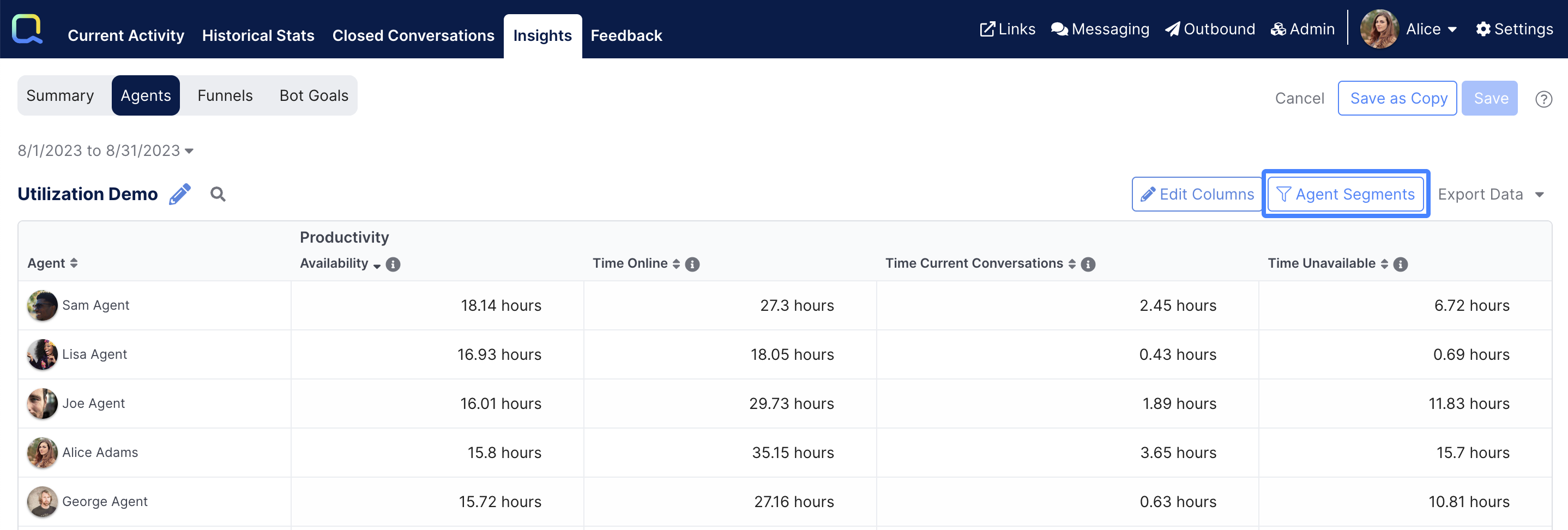
A Create New Agent Segment button is available along with any existing Agent Segments:

Creating a new Agent Segment
Select the Create New Agent Segment button to open the segment editor:

Each segment can be defined to select a group of users by:
- Constraints defining a constraint, or group of constraints, to select a group of users by filtering on their e-mail address, username, or the role to which they are a member
- Always include allows for the individual selection of one or more users to always be included in the segment
- Always exclude allows for the selection of individual users to remove from the segment when they are included with the defined constraints
Once a segment contains at least one constraint, or at least one user has been identified to always include, and a name has been given, the segment can be saved and can be applied to the Agents table:
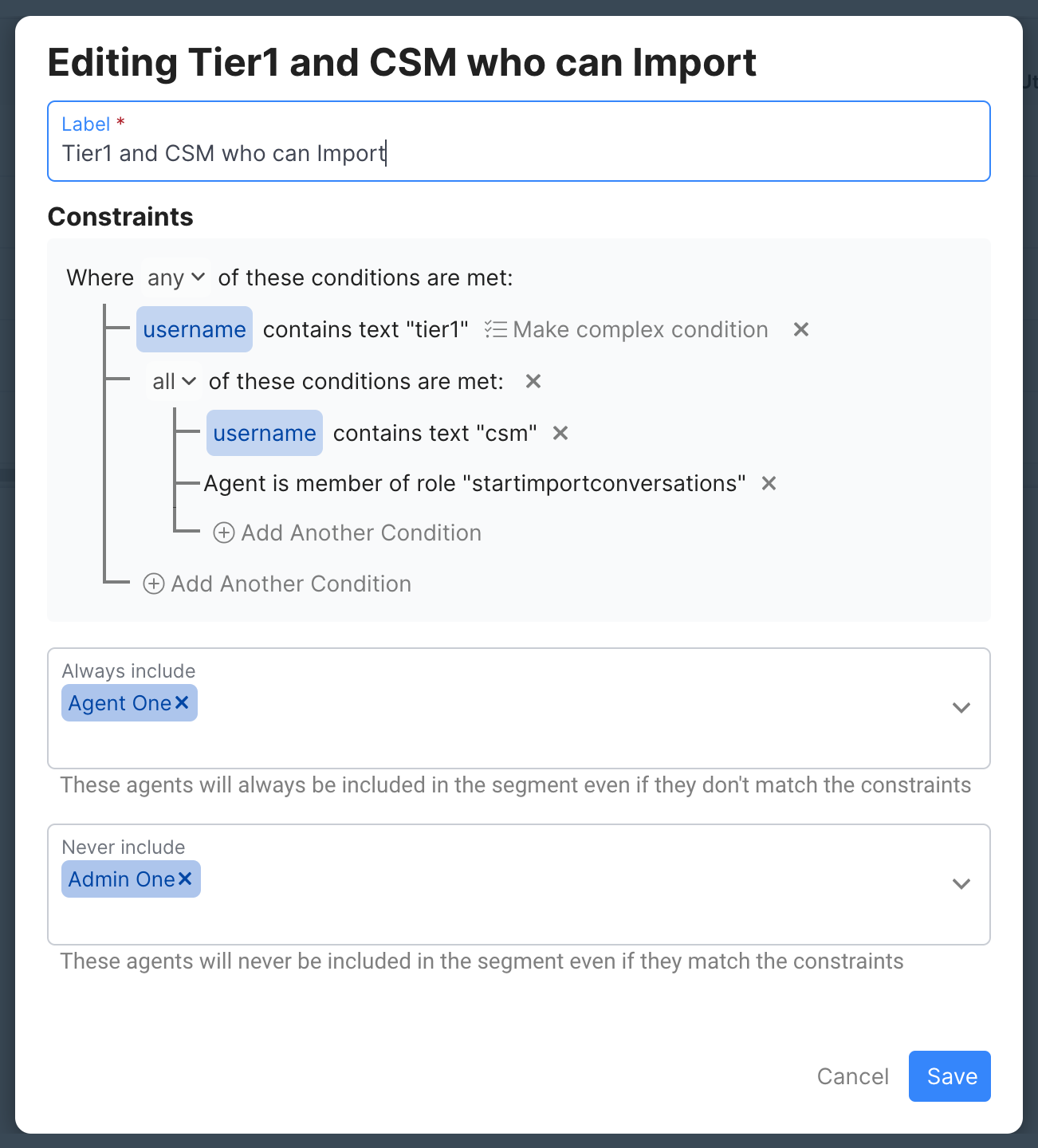
Applying Agent Segments
An Agent Segment will not be automatically applied to the data after it is saved. To apply an Agent Segment, select the checkbox to the left of the name in the selection list:
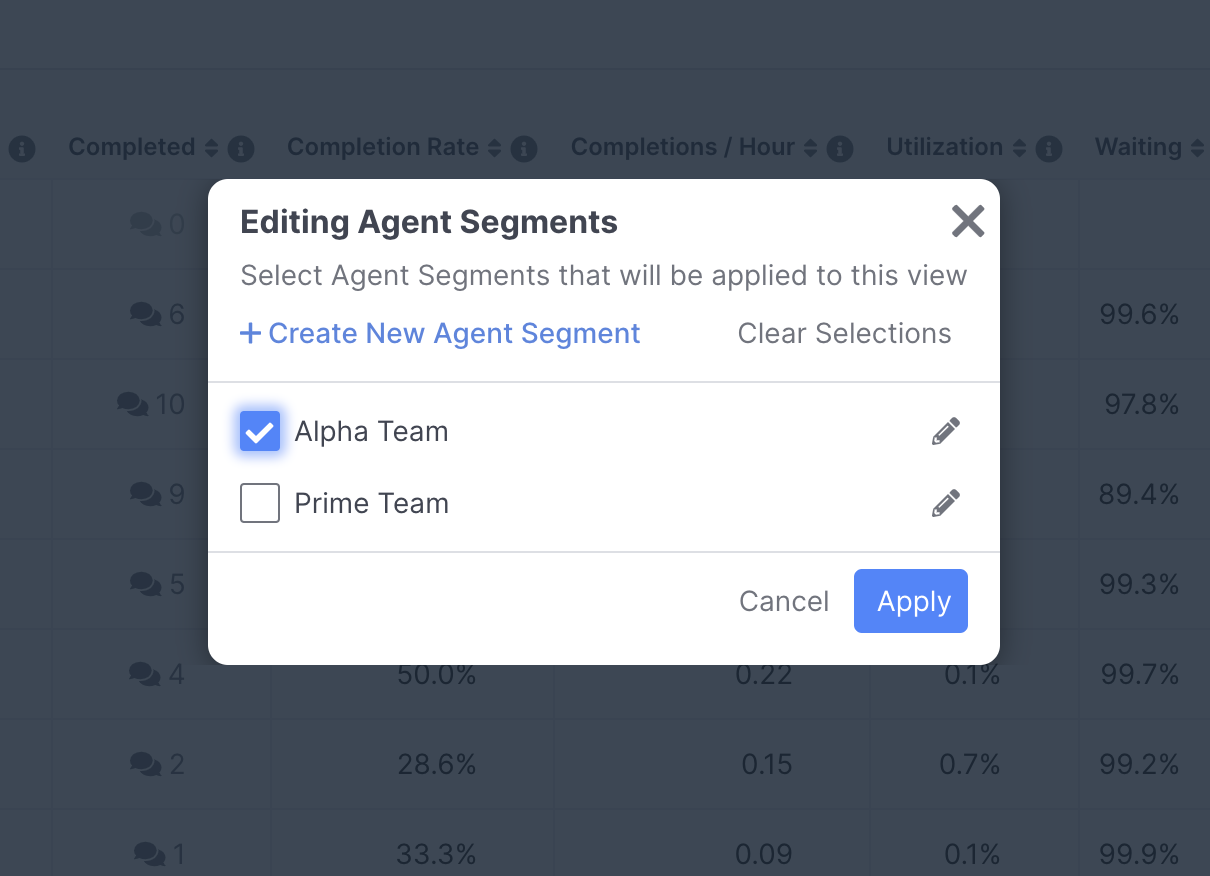
Unlike other Segments, multiple Agent Segments can be applied at once. This will have the overall effect of returning the agents that match any of the selected segments, and each selected segment will be listed as a separate grouping in the returned results:
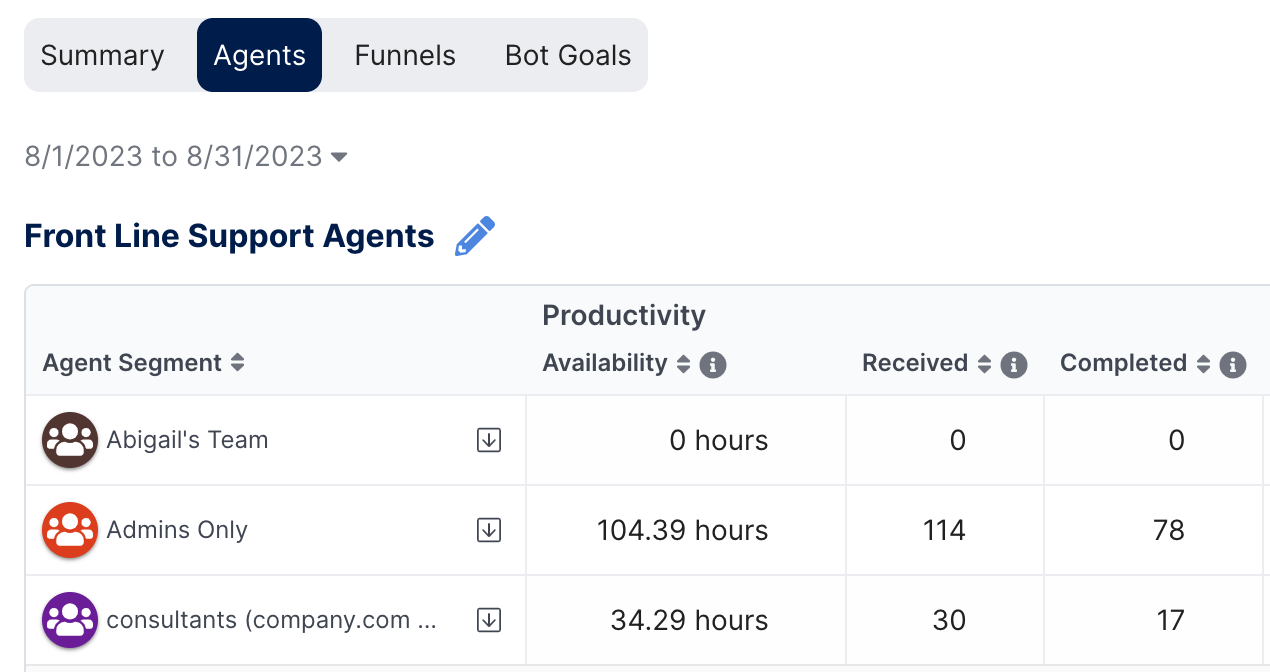
Any segment can be expanded to view the data for the individual agents who belong to that segment:
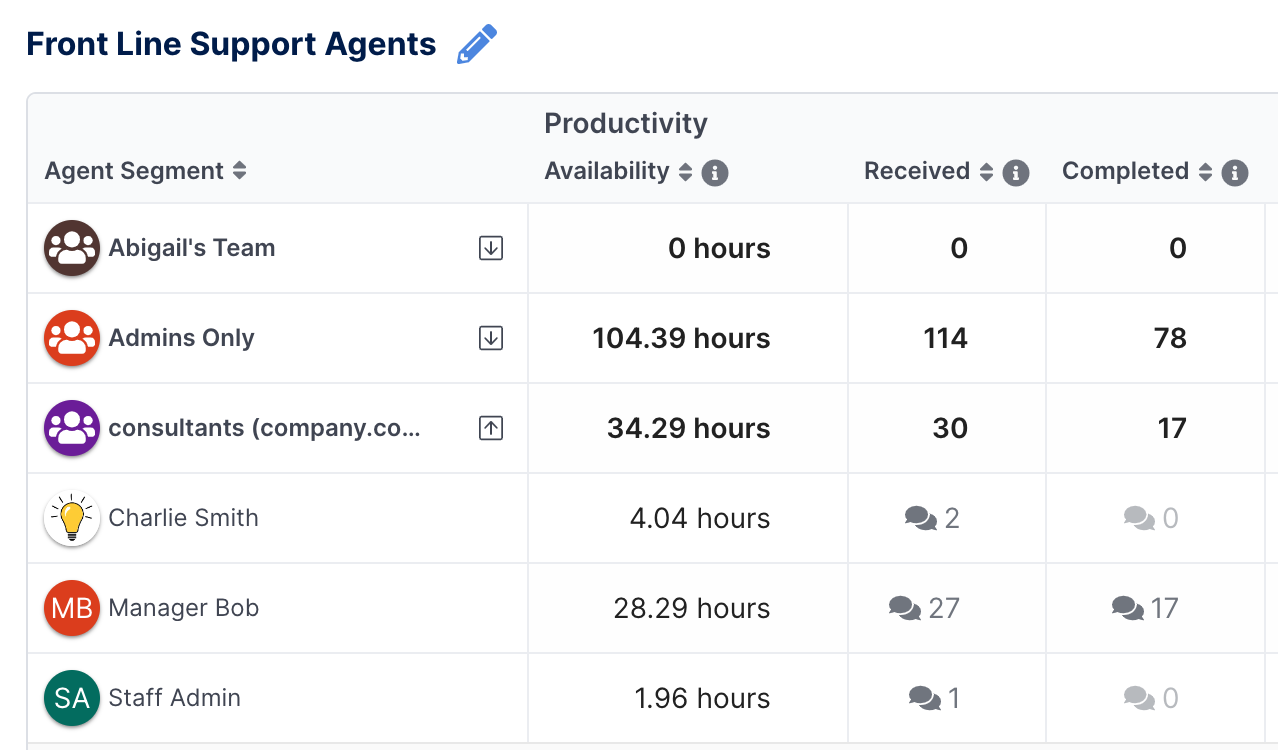
Resolving Agent Segment Conflicts
Sometimes when multiple segments are selected, there will be conflicts if the same agent matches more than one of the defined groups. If at least one agent matches one or more of the selected segments, the Agent Segmentation Conflicts dialog is automatically opened:

Every agent who matches more than one segment will be listed. By default, each agent is listed with the Unassigned segment.
Any agent can be left associated with the Unassigned segment, and the results will show an Unassigned grouping along with those for the selected segments. Each agent will only be listed with one selected segment.
Any segment can be expanded to view the data for the individual agents who belong to that segment:
Save the View
When changes have been made by editing the View, or by applying segmentation, Save buttons become available in the upper right.

Save will apply the changes to the currently selected View.
Save Copy allows you to create a new View with the current changes saved, leaving the current View unchanged.
Cancel will discard any changes.
Reviewing Conversations for a Metric
To help analyze and review the data, any column that is a count of some conversation event supports drill-down. The columns are marked with a message bubble indicating that drill-down is available:
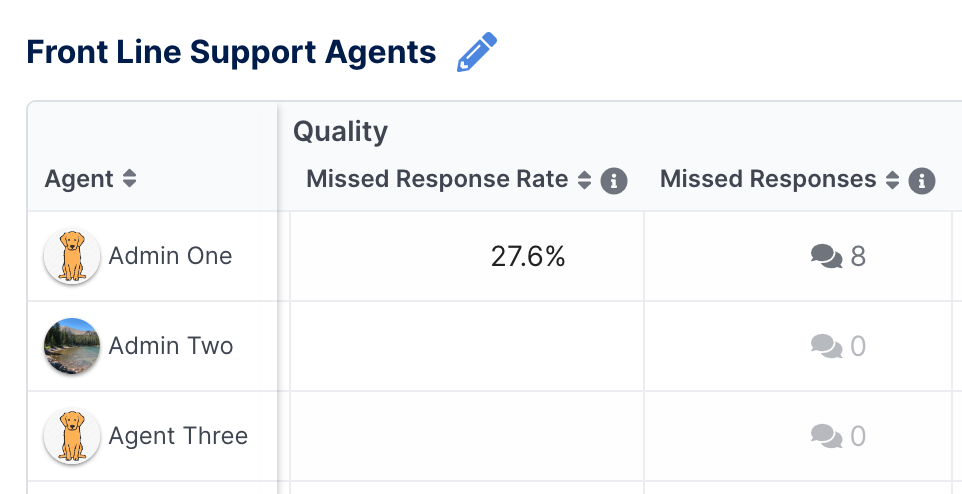
Selecting the bubble will open a drill-down pane that shows the conversations that were counted for that agent for the selected metric.
Each conversation can be selected to show the transcript details that occurred around the time of the event.
For example, if it was observed that some agent had a higher than average Missed Response Rate, a Manager could review the conversation transcripts to gain insight into what was causing the agent to not respond in time:

Time Series Drill-downs
Row Drill-downs
Row drill-downs are available to show all the metrics for a selected agent, or agent segment, broken down by Day, Hour, or Half Hour intervals. This allows you to further evaluate one particular agent, or agent segment, by time. Clicking the name of any agent will open a new time series row drill-down view:
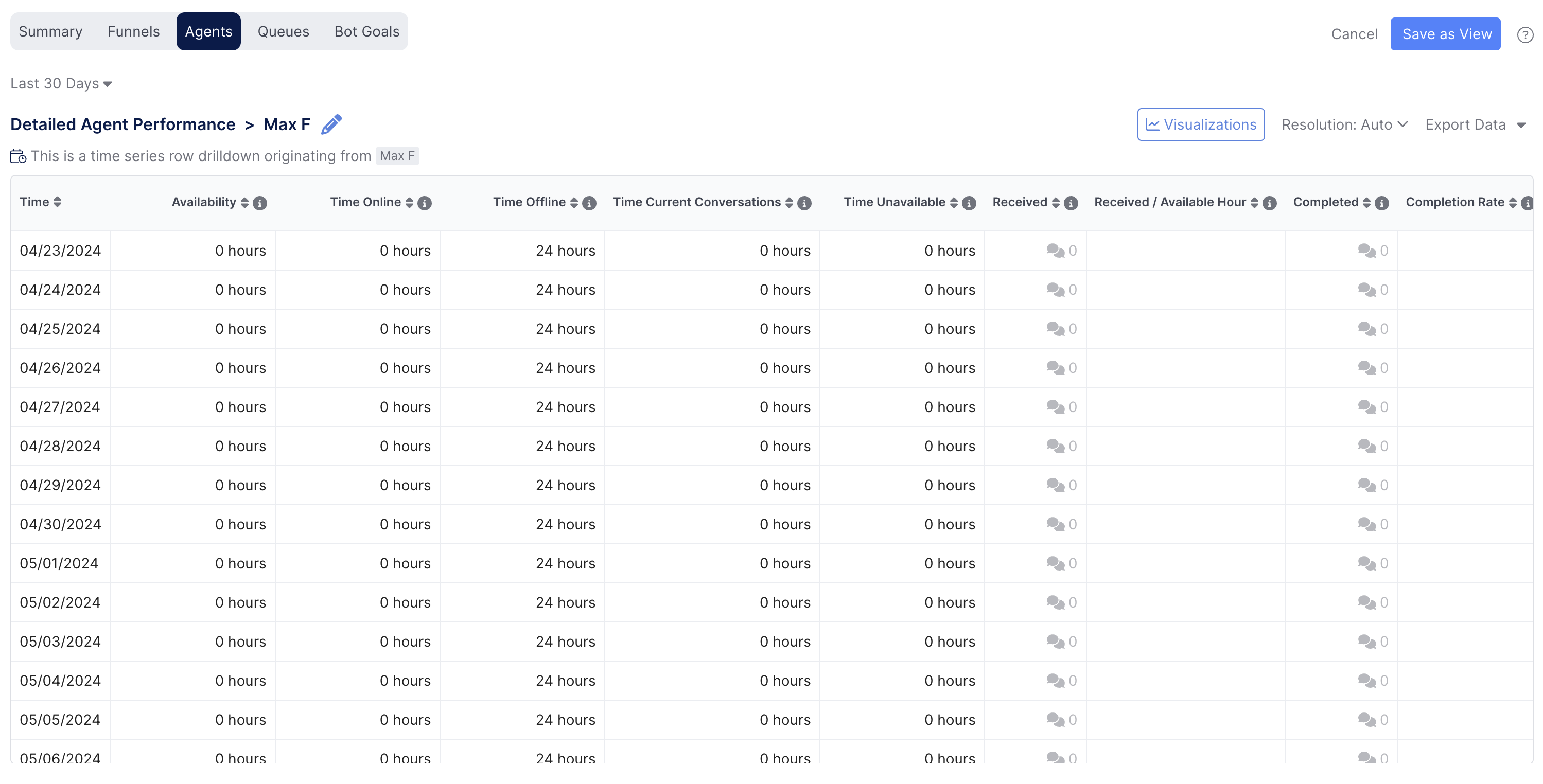
The Resolution will automatically be set to Auto, letting the system decide what time units to use. It can be changed to , Day, Hour, Half Hour, or Quarter Hour:
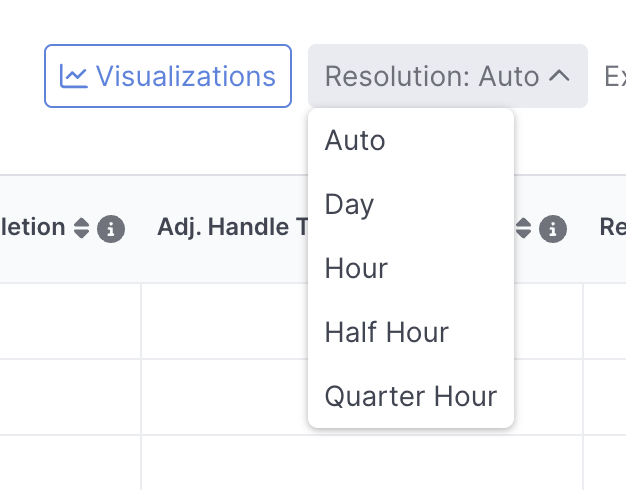
A breadcrumb path displaying the name of the agent drilled into is available in the upper left to return to the parent view.
Column Drill-down
Column drill-down is available to show all the agent data for one selected metric broken down by Day, Hour, or Half Hour intervals.
To access a column drill-down, select Time Drill-down from the options menu in the column heading:
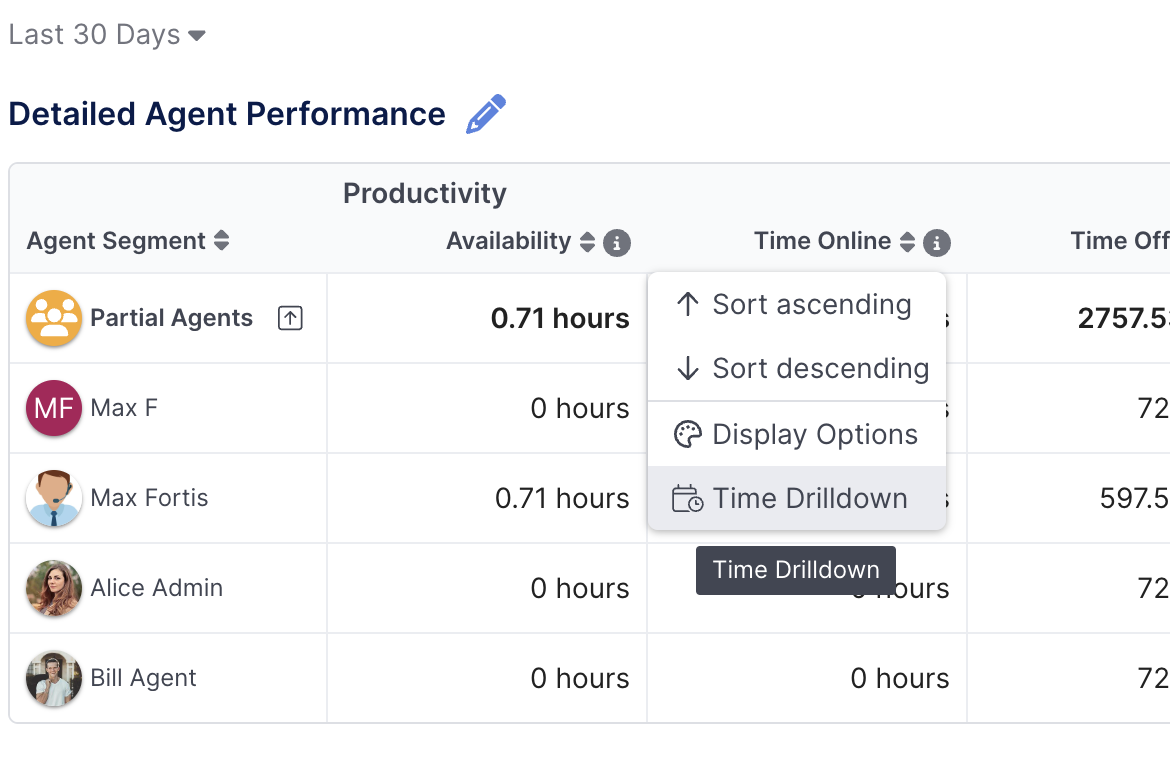
The column drill-down view will be displayed for the selected metric. This allows you to further evaluate one particular metric by time:

The Resolution will automatically be set to Auto, letting the system decide what time units to use. It can be changed to Hour, Day, Half Hour, or Quarter Hour.
A breadcrumb path displaying the name of the metric drilled into is available in the upper left to return to the parent view.
Cell Drill-down
Cell drill-down is available to show the data for one particular agent, or agent segment, and one metric broken out into a table showing the data values per Day and per Hour (or Half Hour).
To access a cell drill-down, hover over a cell with data until the calendar button displays, then select the cell:
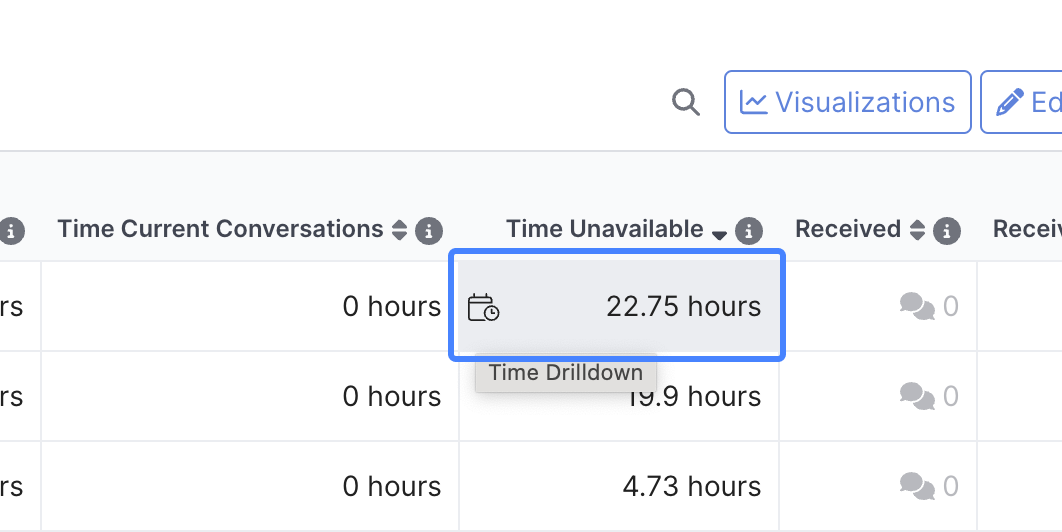
The column drill-down view will be displayed for the cell. This provides a "heat map" of the data by day (rows) and time of day (columns) for the selected metric and agent.
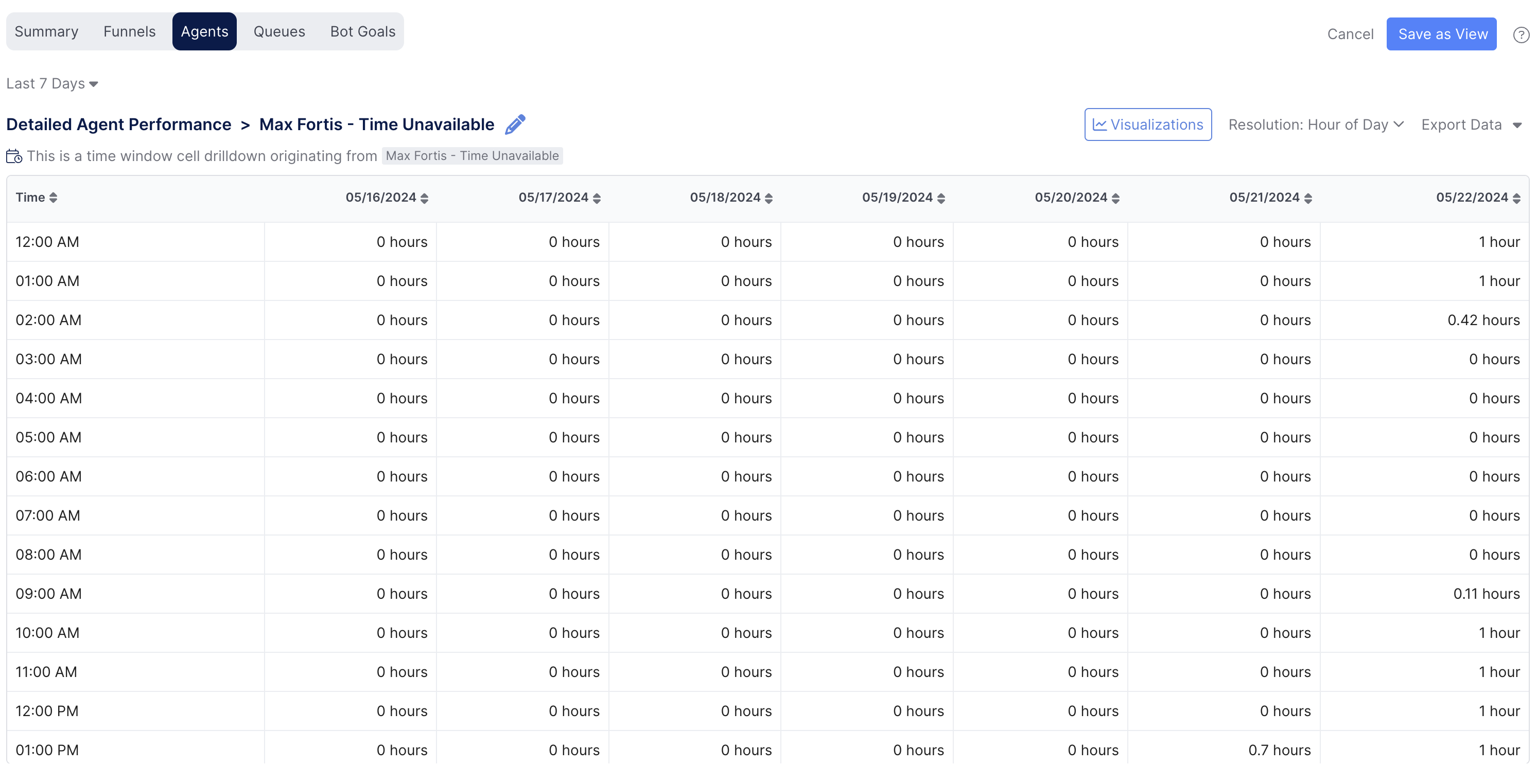
Selecting the Visualization button in the upper right will allow you to add color to the table such that the higher "hot" values appear in red. This can quickly identify any time periods with higher than normal values. Enable the background coloring by checking the Show heat map box in the dialog.
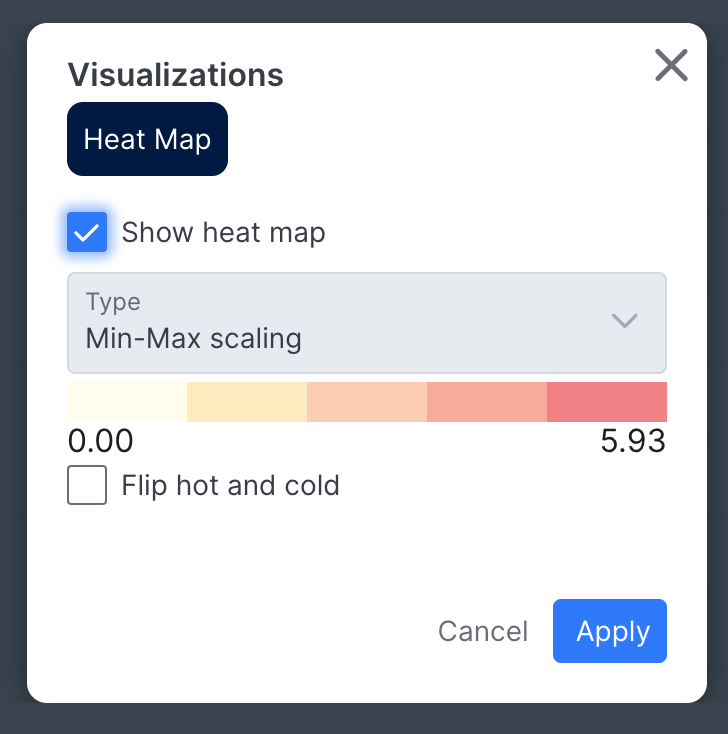
Hitting Apply will then show the background coloring for the heat map in cell drill-downs:
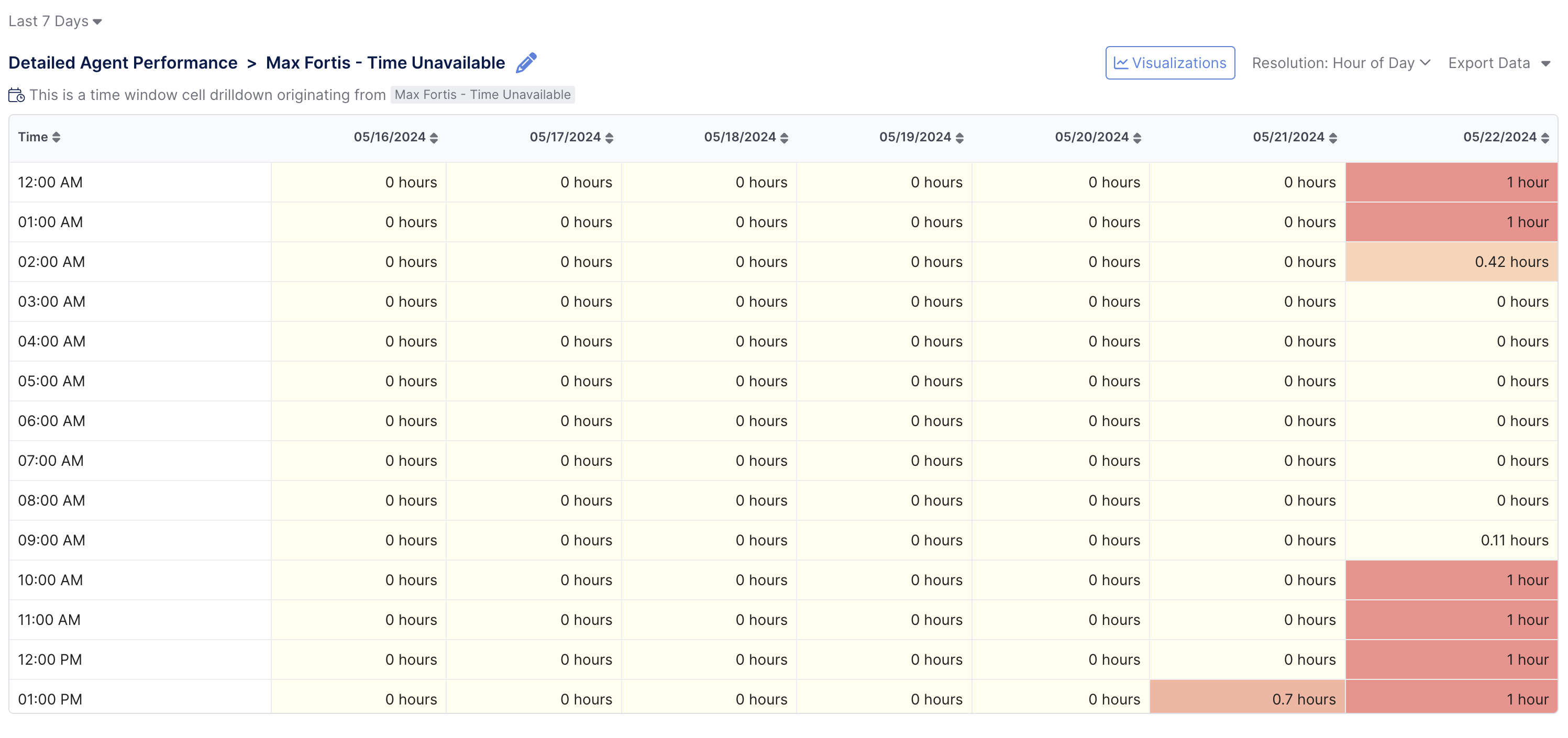
The Resolution will automatically be set to Auto, letting the system decide what time units to use for columns. It can be changed to Hour, Half Hour of Day, or Quarter Hour of Day.
A breadcrumb path displaying the name of the agent and metric drilled into is available in the upper left to return to the parent view.
Saving a Drilldown View
When in any drill-down, Admin users have the option to save the report as a view. This view is then available in the view list on the main Agent Insights screen. This allows a user to directly open a heat map or some other time series breakdown of the selected agent(s) or metrics.
These views behave differently than standard Insights views since they are always defined to be associated to a particular metric, agent (or agent segment) or both. One cannot Edit Columns, change Agent Segments, modify Display Options, or do additional time drill-downs from these views. The data can still be viewed and exported for different date ranges.
The time series drill-downs are flagged with the calendar icon after the name in the main List View:

Managers can drill down on views they have access to, but cannot save new views.
When using a selected date interval of more than 1 month, and choosing a Resolution of Hour_or_Half Hour, the results will be truncated to include only the first month in the selected date interval. The Day option will allow the user to see all the data in the time period.
Exporting Data
You can export the data into a CSV formatted file by selecting Export Data > Agent Performance Data from the top toolbar. Only the columns available in the view are included in the CSV file. Display options are ignored and data will be returned in raw format.
Agent Insight Metrics
You can view the available metrics and definitions in the Agent Insights Metrics section.
Updated about 2 months ago
